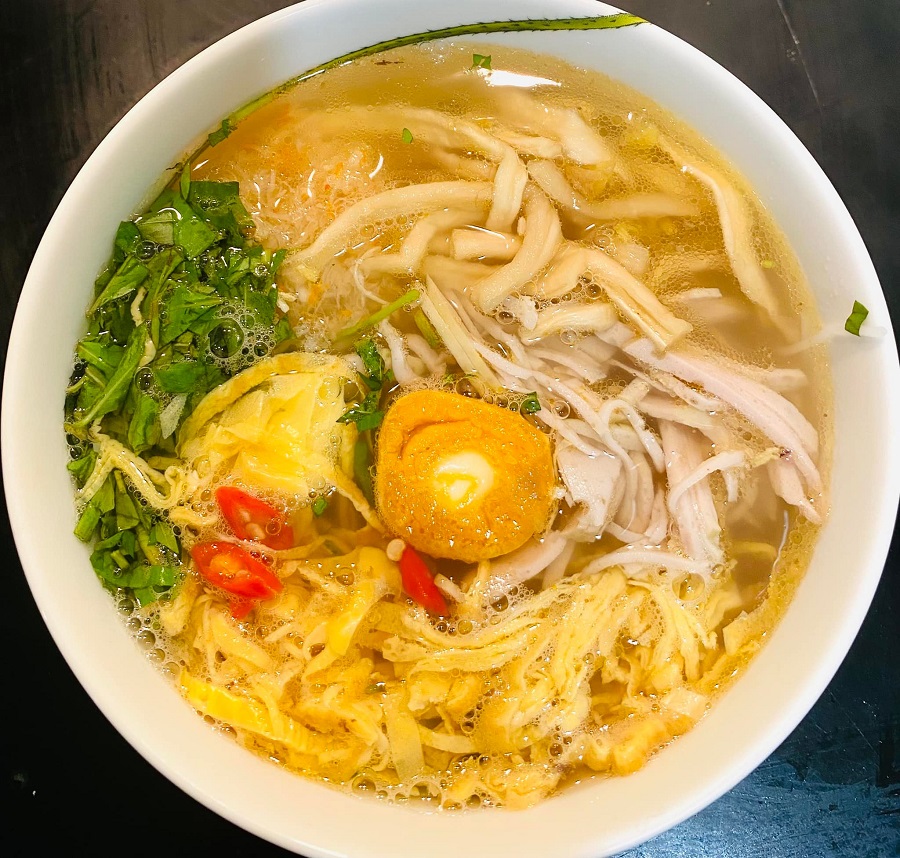Street foods you should not miss when visiting Hoan Kiem Lake
Thuy Ta ice cream, the distinctive aroma of Ms.Lan's Khuc-pie wrapped in fresh lotus leaves, and the flavorsome taste of Bao Khanh chicken noodle soup may help diners in Hanoi to have the most enjoyable culinary experiences.
Hanoi is in autumn. The streets are carpeted with yellow leaves, the breeze blows gently, and the sunlight sprinkles the right amount of warmth on every corner. Don’t miss the most beautiful days of the year to stroll around and enjoy Hanoi’s delicious street food!
Let The Hanoi Times bring you to some delightful eating venues near Hoan Kiem Lake - the iconic place of Hanoi.
Try the tropical aromatic Thuy Ta Ice-cream
| Visitors to Hanoi enjoy Thuy Ta ice cream. Photo: MC Hoang Phuc |
For Hanoians, having a Thuy Ta’s ice cream by Hoan Kiem Lake is not only to enjoy a cool, delicious snack but also to maintain a habit handed down from generation to generation.
Thuy Ta ice cream came along in Hanoi a long time ago. The brand name is believed to be even older than the famous Trang Tien ice cream. Since 1954, French chefs have introduced delicious sweet treats to local consumers. To better suit the taste of Hanoians, they created ice cream from tropical ingredients such as lemon with mint, orange, banana, mung bean, young sticky rice, taro, or mulberry, among others.
Over time, the ice cream of Thuy Ta restaurant has been remarkably improved with various flavors that can satisfy the taste buds of every discerning diner from Europe or Asia. It is now featuring 52 flavors of ice cream, divided into three lines of popsicles, an ice cream box, and an ice cream cup.
Having nice ice cream in a luxurious restaurant with breathtaking views over the deep-emerald Hoan Kiem Lake is a funky way to enjoy a snack in Hanoian style. “When in Rome, do as the Romans do,” and when you are in Hanoi, try the gelato in the Hanoian way!
| Thuy Ta ice cream has been famous in Hanoi since 1954. Photo: Thuy Ta Legend Restaurant |
Have a tasteful chicken soup of Pho ga Bao Khanh
While the Pho bo, or Vietnamese traditional noodle soup with beef, is familiar among international food connoisseurs, the Pho ga, or rice noodle soup with chicken, seems less well-known.
However, the “fragrant, delectable and balanced” taste of the toothsome dish has won the hearts of many diners, including Penny Wong, Australian Foreign Minister. Together with Australian Ambassador to Vietnam Robyn Mudie, the politician enjoyed Hanoi's specialty during her first visit to the city in the middle of this year.
When diners place their orders, the cook adds slices of chicken to a bowl of broth on top of rice noodles, then sprinkles it all with sliced onion, chopped green onion, fresh coriander, and some tiny slices of lemon leaves.
Depending on their preferences, diners may order the dish with different topping options, including noodle soup with chicken breast with or without skin, noodle soup with chicken thighs, boneless chicken wings or legs, and chicken young eggs, among others.
In Hanoi, it is worth trying once the “Pho ga Bao Khanh” or chicken rice noodle soup in Bao Khanh Lane stall, and any visitor to the capital should not miss it. The shop owners may have their reason for being so self-conceited. The cook has kept Hanoi's pho in the original recipe: the flat rice noodle soup is thin and soft, the chicken meat is not too soft or stringy, and the broth is clear and sweet stewed from chicken bones.
| The tasty dish of Hanoi's flat rice noodle soup with chicken or Pho ga Hanoi. Photo: Thu An |
Enjoy the distinctive Hanoian dish of Ms.Lan’s Khuc-pie
Finding a light meal in Hanoi’s downtown has always been easy, regardless of the time of day or night. One can enjoy specialties like pho or rice noodles with beef or chicken, banh cuon, or steamed rice pancakes, but one dish that holds a special place in the heart of many Hanoians is the traditional favorite- the banh Khuc or Khuc-pie. The best pie in the city is Ms.Lan’s Khuc-pie on Cau Go Street near Hoan Kiem Lake, which is only available in the evening.
Locals said that after every harvest, the rice fields in the suburban area of Hanoi are covered with the greenery of khuc vegetables- the main ingredient of the khuc-pie. After picking, the tiny leaves are washed in water before being boiled, then ground in a stone mortar, and then mixed with sticky rice flour to make a dark-green mixture, which is rolled into portions the size of a child’s fist.
Each piece is then rolled in boiled green peas and pepper-soaked half-fat and half-lean meat. Finally, the Khuc-pies are layered into a large steamer, each layer covered with carefully soaked sticky rice until the pot is full.
Ms.Lan’s Khuc-pie is always covered with fresh lotus leaves to lend the dish the flavor of the flower. The fragrance of sticky rice and Khuc-pie steaming together is a comforting one for many Hanoians, and the combination of Khuc, green peas, and spiced meat makes for a uniquely northern taste sensation not to be missed if you are in the place at the right time of year.
A Hanoi’s full of flavor specialty- Ms.Lan’s Khuc-pie. Photo: Huyen Trang |
Savor the flavorful bowl of Bun thang Cau Go
For years, the tiny food stall on Cau Go Street, near Hoan Kiem Lake, has been renowned among Hanoian diners for its special hot dish of Bun thang or mixed rice noodle soup.
A northern specialty, Bun thang is a dish that stimulates your senses with its pungent broth, excellent color, and intense flavors. The noodles used to make Bun thang must be thin, soft, and fragrant rice and the ham used in the dish should be tender and come from Uoc Le Village, which is famous for its Vietnamese-style ham. The chicken used in Bun thang must not be too harsh or too soft and shredded into thin strips, while dried turnip, onion, Sa Sung, or sea leech add flavor to the broth.
The quality of a bowl of Bun thang depends first and foremost on the broth. The sweetness of the broth should not come from sodium glutamate. It should be free from the strong flavor of ox or buffalo bones. Therefore, the broth has to be prepared from chicken bones cooked with shelled prawns. These ingredients achieve the required sweetness and produce a clear broth that should be boiled up to the serving time.
Bun thang must be served in big bowls to retain its heat and flavor. The broth should be clear and ivory-yellow. The essence of this specialty, the quintessence without which a bun thang dish cannot be perfect, is belostomatid essence, a squeezed excretion of an endemic beetle. Just a little of the essence and a spoonful of shrimp paste perfectly enhance the rich flavor of the dish.
| A simple yet delicious specialty of Hanoi: the Bun thang or mixed rice noodle soup. Photo: Trinh Le Phong |




.jpg)











